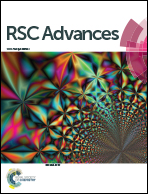An in situ gold-decorated 3D branched ZnO nanocomposite and its enhanced absorption and photo-oxidation performance for removing arsenic from water†
Abstract
In this study, we report a one-step, low-cost and environmentally benign route to tune ZnO morphology via the in situ reduction of Au nanoparticles as crystal habit modifiers. Pure ZnO had spindle shape morphology. When the Au particles were introduced to the system, the growth form of the ZnO crystals was changed. Finally, ZnO grew along different directions to form a 3D nanobranched morphology. This unique 3D nanobranched ZnO/Au compound exhibits enhanced absorption and photooxidation performance for AsO2− (As(III)). What is more, the efficiency could be improved by optimizing the Au content to 1%. The adsorption kinetics, which were explored in detail, indicated that Au decoration significantly changed the surface properties of the samples. The zeta potential of the ZnO/Au samples was more positive, which is beneficial for the adsorption of AsO2− (As(III)) with negative charges. Moreover, the enhanced photooxidation performance was attributed to the coupling of Au noble metal nanoparticles and the 3D branched structures. Thus, this facile method was expected to adsorb and oxidize As(III) from contaminated water in one step. What is more, usage of noble metal particles, which are formed in situ, as habit modifiers to tune the growth form of crystals can be extended to the preparation of other metal oxide.


 Please wait while we load your content...
Please wait while we load your content...